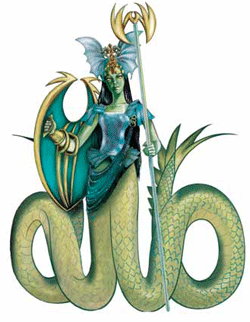tl;dr: Most likely, the 3.5 edition dragonborn are derived from earlier 1st edition reptilian/draconian creatures, which were likely inspired by earlier humanoid reptiles (such as the Silurians from Doctor Who).
D&D Precursors to Dragonborn
The earliest examples of a creature resembling a dragonborn in D&D lore, that I am aware of, comes from the 1st edition, and went by a few different names.
In the core 2nd edition Monster Manual, they were called Sauriels. Though the creatures looked like dragons, they were actually distantly related to dinosaurs, so they only vaguely count as "proto-dragonborn." These creatures were also present in the 1st edition Forgotten Realms setting, and appear in print originally in the novel Azure Bonds, published in 1988.
Even earlier, in the Dragonlance setting, there was a similar but distinct creature called a Draconian. These were either 5 races, or a single race with 5 variations, all created by magically corrupting the eggs of the metallic ("good") dragons. They were the foot soldiers in the armies of Takhesis, the 5-headed chromatic dragon (basically a re-skinned Tiamat) that is the main villain of the War of the Lance. They appear in print in the novel Dragons of Autumn Twilight, published in 1984.
These are much closer to what the current dragonborn race is supposed to be, except they were universally chaotic evil and blindly followed Takhesis and her generals orders.

Outside D&D
While I'm not aware of any fictional creatures from other works that I'd call dragonborn-ish, there are several creatures that might be the inspiration for the dinosaur-like Saurials. The most notable of these are the Silurians from Doctor Who: a reptilian race called homo repitlius that lived beneath the Earth's surface that predates homo sapiens.
These creatures were first shown in 1970, in the Season 7 episode Doctor Who and the Silurians, which pre-dates D&D by several years.


Mythology
There are several other creatures in mythology that have vaguely dragon-like features, but none that I can find that exactly match the description of a humanoid descended from dragons.
The closest I can find is an ancient Greek mythological creature called a dracaena or drakaina. This is a female dragon that is usually depicted as having human-like features. (side note: DO NOT google Drakania at work.). I couldn't find a good image of one other than this from Rick Riordan's site (the author of the Percy Jackson books):





